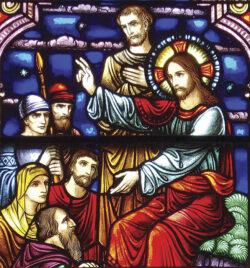By affirming that those dead Galileans were no more sinners than his interlocutors, Jesus uses a psychological resource to warn them more vividly about the intrinsic gravity of sin and the corresponding penalties: our daily life must be ordered towards eternal life.
Newsroom (24/03/2025 15:58, Gaudium Press) Shortly before the episode in which the people were gathered in the Temple for the Passover offering, some Galileans, dissatisfied with Roman rule, took advantage of the large gathering of pilgrims to start a sedition against Caesar’s authority: “At that time, some people came bringing news to Jesus about the Galileans whom Pilate had killed by mixing their blood with that of the sacrifices they offered” (Lk 13:1).
When Pilate heard about this, he was indignant and had the rioters executed. When the soldiers entered the Temple courtyard, in addition to those who had promoted the uprising, they also killed other Galileans who were there to offer the usual sacrifices, thus spilling innocent blood. The news caused quite a stir and some people rushed to tell Jesus what had happened [1].
On the subject of temporal punishment, he warns of eternal punishment
“Jesus answered them, ‘Do you think that these Galileans were more sinful than all the other Galileans because they suffered such a thing? I tell you, no. But if you do not turn, you will all die in the same way’” (Lk 13:2-3).
The bearers of the news imagined that, as a Galilean, Jesus would naturally take the side of his dead compatriots. Perhaps they even hoped that the brutality of the repression would lead the Divine Master to speak out in favor of Jewish nationalism.
Jesus’ thoughts were always on a much higher plane than political disputes. In his response, he doesn’t get involved in the specifics of the issue, but takes advantage of the situation to teach a moral lesson, summarized by Fillion: “Without judging the governor’s behaviour or going into political discussions, he reminds his listeners that, since they have all offended God, they are all exposed to the blows of divine justice as long as they don’t repent and sincerely convert.”[2]
Here we find a first attitude of Jesus to imitate: when a fact of daily life appears to be of special interest, let’s avoid analyzing it only according to its earthly aspects, and let’s try to elevate ourselves to the supernatural plane in order to better judge it.
On the other hand, in the opinion of Cardinal Gomá and the other professors of the Society of Jesus, the content of the Divine Master’s reply was intended to correct an erroneous idea common among the Jews of that time, according to which every pain was a punishment.[3] However, as Cardinal Gomá teaches, only the Lord “knows if there is any relationship between personal sins and the misfortunes that befall someone; the examples of Job, Epulam and Lazarus disprove the erroneous and superstitious theory of the Jews.”[4] The Divine Master said that the Galileans who had died were the ones who had died.
By affirming that those dead Galileans were no more sinners than his interlocutors, Jesus uses a psychological resource to warn them more vividly about the intrinsic gravity of sin and the corresponding penalties. For, as Maldonado says, “Jesus intended to warn his listeners, impressed by the account of that temporal punishment, about the eternal penalty, as if to say to them: […] do not think that those who have suffered this bodily death are miserable, but rather those who will suffer the death of the soul, and this will surely fall on all of you if you do not do timely penance.”[5]
Extracted, with alterations, from: CLÁ DIAS, João Scognamiglio. The unpublished Gospels: commentaries on the Sunday Gospels. Città del Vaticano-São Paulo: LEV-Instituto Lumen Sapientiæ, 2012, v. 5, p. 213-215.
[1] Several ancient commentators, including St. Cyril, identify this episode with the revolt of Judas Galileo, narrated by St. Luke himself in Acts 5:37 (cf. SAINT CYRIL, apud SAINT THOMAS OF AQUIN. Catena Aurea. In Lucam, c.XIII, v.1-5). However, more recent authors, such as Louis-Claude Fillion and the professors of the Society of Jesus, consider it to be a different event, which happened shortly before the episode narrated here (cf. FILLION, Louis-Claude. Life of Our Lord Jesus. Public life. Madrid: Rialp, 2000, v.II, p.387; LEAL, SJ, Juan; DEL PÁRAMO, SJ, Severiano; ALONSO, SJ, José. Sacred Scripture. Evangelios. Madrid: BAC, 1961, v.I, p.696).
[2] FILLION, op. cit., p. 387.
[3] Cf. LEAL; DEL PÁRAMO; ALONSO, op. cit.
[4] GOMÁ Y TOMÁS, Isidro. The Gospel Explained. Año tercero de la vida pública de Jesús. Madrid: Rafael Casulleras, 1930, v.III, p.244.
[5] MALDONADO, SJ, Juan de. Comentarios a los Cuatro Evangelios. Evangelios de San Marcos y San Lucas. Madrid: BAC, 1951, v.II, p.616.
Compiled by Teresa Joseph




































